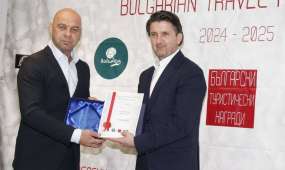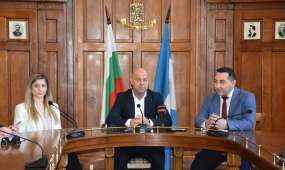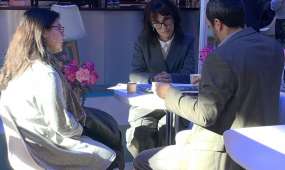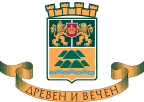Spiritual routes in Plovdiv 2022
The thematic journeys "Spiritual Routes in Plovdiv 2022" have started.
This year they will hold in June and September-October.
Letera Publishing House is pleased to invite Plovdiv residents and guests to a curious, beautiful and exciting journey through the depths of our city, full of culture, history and presented in a fascinating story. "Spiritual routes in Plovdiv 2022" will be held in two stages - in June and in September-October. The project is a kind of continuation of "Literary Travels in Plovdiv", which took place in 2019 within Plovdiv - European Capital of Culture, as part of the program of the Foundation "Plovdiv 2019". Due to the exceptional success and high public interest in the project "Literary Travels in Plovdiv" in 2020, 2021 and now in 2022, the publishing house "Letera" continued and further developed thematically under the title "Spiritual Routes in Plovdiv". The project is funded by the Municipality of Plovdiv under Component 1 "Festivals and significant events" and is part of the Cultural Calendar of the city.
The first route is called "The fortress walls of Philippopolis". It will be held on June 4, 2022, Saturday, starting at 10:00.
Meeting point: The Eastern Gate of Philippopolis, Alexander Malinov Square (the roundabout on Metropolitan Panaret Street)
Leader: Maya Martinova-Kyutova, archaeologist
Researcher of some of the most significant archeological sites in Plovdiv, participated in the projects for exhibiting the Odeon, Forum North, Philippopolis Stadium, East Gate.
The East Gate The Round Tower The Tower next to the Holy Sunday Church The fortress wall on Vitosha Street Lapidaruim
SECTOR 1: The eastern gate of Philippopolis
This is one of the most important architectural ensembles from antiquity on the territory of Plovdiv. A street with a width of 13.20 m was discovered, with sidewalks and porticos on both sides, which leads to one of the city gates. The gate is planned to be a tripilon with one central and two small entrances. The complex, which has reached us with its layout from the IV century AD, was built on the ruined fortress wall from the II century AD. The Eastern Gate occupies an important place in the defense system of Philippopolis. The monumental layout of the architectural ensemble proves that this is the most prominent city gate, and the street leading to it is the main entrance-exit artery of the ancient city.
SECTOR 2: The complex "Round Tower with Proteichism" next to the church "St. Constantine and Helena "
The Hun attacks in Thrace from the middle of the 5th century AD. imposed the strengthening and reorganization of the fortification system of the city. The Round Tower with Proteichism complex is part of the early Byzantine fortress wall of Philippopolis, which covered the Three Hills. It is a fortress wall in the opus mixtum.
SECTOR 3: The fortress wall on Vitosha Street
Here are preserved fortress walls, built in 172 AD. in the time of Emperor Marcus Aurelius. Next to the outer face of the Roman fortress wall during the early Byzantine period a new fortress wall was built with alternating triangular towers and buttresses, which provided protection for the Three Hills, where troops were traditionally housed and the population sought protection during attacks.
The second route, which is forthcoming, is entitled "On and under the Main Street" and awaits you on 11.06.2022, Saturday, 10:00.
Meeting point: Ancient Forum (under the clock of the Central Post Office).
Leaders will be Maya Martinova-Kyutova, archaeologist, and Teodor Karakolev, art historian. Participation is free!
Maya Martinova-Kyutova is a researcher of some of the most significant archeological sites in Plovdiv, participated in the projects for exhibiting the Odeon, Forum North, Philippopolis Stadium, East Gate.
Teodor Karakolev studied art in the period between the two world wars. He is engaged in research and promotion of architecture and art at the Bulgarian Architectural Modernism Foundation and in journalism in the field of culture.
The route includes a visit to the Ancient Forum, Odeon, Stefan Stambolov Square, Main Street, Roman Stadium - underground route: restored parts of the Ancient Stadium in the cinema "Excelsior", in the building of the H&M store and in the Roman Stadium
THE FORUM OF PHILIPPOPOL
The agora (forum) of Philippopolis is not only a commercial, administrative and religious center of the ancient city, but also a gathering place where meetings, debates, holidays were held. On its northern side there is a complex of public buildings. The city magistrates met in the Odeon / Boulevardion. To the west of it are the city library, the civil basilica and the Treasure Building. This part of the city square of the Roman city was soon opened to tourists after many years of conservation and restoration work.
THE STADIUM OF PHILIPPOPOL
The stadium of Philippopolis was built at the beginning of the 2nd century AD. It is located at the northern end of the fortified city, between the two fortress walls, in the natural fold between the western slope of Taksim Tepe and the eastern slope of Sahat Tepe. The stadium (240 x 50 m) gathered 30,000 spectators. The northern arched part of the stadium (sphendon) is exposed in situ on the Roman Stadium Square. Philippopolis Stadium is one of the few Roman public buildings mentioned by ancient authors in the context of significant historical events. Parts of it have been restored in the underground spaces of the modern commercial buildings on the Main Street.
MAIN STREET
The main street "Prince Alexander I" received its current appearance mainly in the years from the Liberation to the Second World War, with some changes after that. Today, the architectural ensemble preserves beautiful buildings in the Art Nouveau, Art Deco and Modernist styles. The street is a symbol of the desire to Europeanize Bulgaria after the Liberation, all buildings are the work of architects who graduated in Western Europe with the most current trends of their time.
The third route will reveal the secrets of the Episcopal Basilica of Philippopolis, told by two ladies who have dedicated years of their lives in the study and restoration of this treasure of the millennial Plovdiv.
Elena Kantareva-Decheva and Jeni Tankova will present the most interesting facts and stories about the discovery of the basilica and the restoration of the ancient mosaics in it. Guests will get acquainted with the modern space of the Visitor Center, which houses antique mosaics, interactive exhibitions and virtual reconstructions of the interior of the church.
Route: The Episcopal Basilica of Philippopolis, June 18, 2022, Saturday, 10:00 a.m.
Meeting point: in front of the entrance of the Episcopal Basilica of Philippopolis
Entrance fee: BGN 10 for adults and BGN 3 for students
Topic 1: Archaeological discoveries
Leader: Zheni Tankova, archaeologist
Head of the archaeological study of the Episcopal Basilica in 2016-2017.
Topic 2: Ancient mosaics and their restoration
Leader: Assoc. Prof. Dr. Elena Kantareva-Decheva, artist-restorer
Head of the restoration of the mosaics of: the Episcopal Basilica (from 2015 until today); The Little Basilica (2011-2014); Eirene Building (2003-2004)
The Episcopal Basilica of Philippopolis is the largest early Christian church in Bulgaria. The size, decoration and central location of the temple near the Forum of the Ancient City testify to the large and influential Christian community in Philippopolis. Its interior was decorated with columns with capitals with Christian symbols, frescoes and lavish mosaic floors. Mosaics are the best preserved part of the building. They are made in three stages, forming two layers with a total area of 2000 square meters.
The fourth route is entitled "Houses on a corner without a right angle" and you can join it on June 25, 2022, Saturday, at 11:00, the meeting point is the garden on the boulevard "Russian", opposite the street " Gen. Danail Nikolaev ". The leader in this journey will be Teodor Karakolev, art historian, and guest - Yavor Berov, photographer.
During the tour we will talk about interesting facts, stories and interesting details about the following houses: 67 Ruski Blvd., 75; Avksentiy Veleshki Street № 15, № 33; "King Assen I" № 3, № 8; 13 Dr. GM Dimitrov Street.
Plovdiv received a modern urban scheme at the end of the XIX century with the work of architect Joseph Schneiter - straight streets, rectangular neighborhoods replace the crooked alleys of the old Filibe. An interesting trend can be seen among many of the buildings built at the crossroads - the corner is beveled and so the curious phenomenon is obtained, called by the photographer Yavor Berov "Houses on a corner without a right angle". We will find out who built them, why and when on a walk along Ruski Blvd. and the neighborhoods in the area.
The next routes in September and October are dedicated to the topics: fine arts, literature and history.











Add new comment